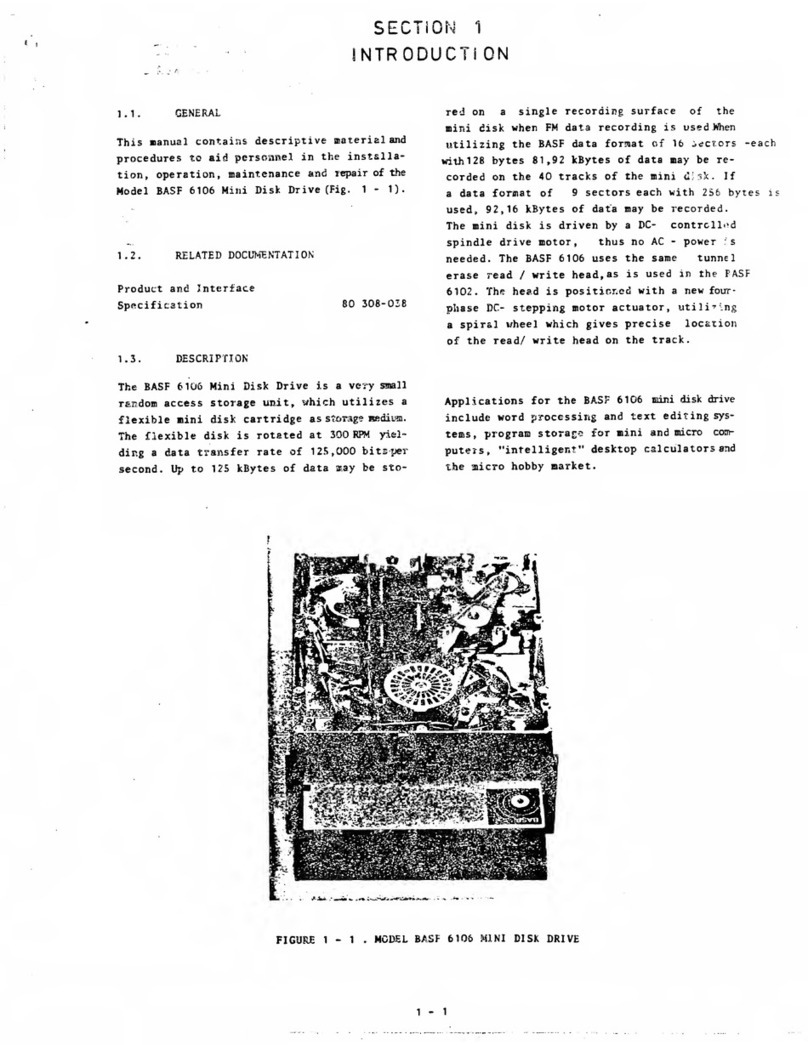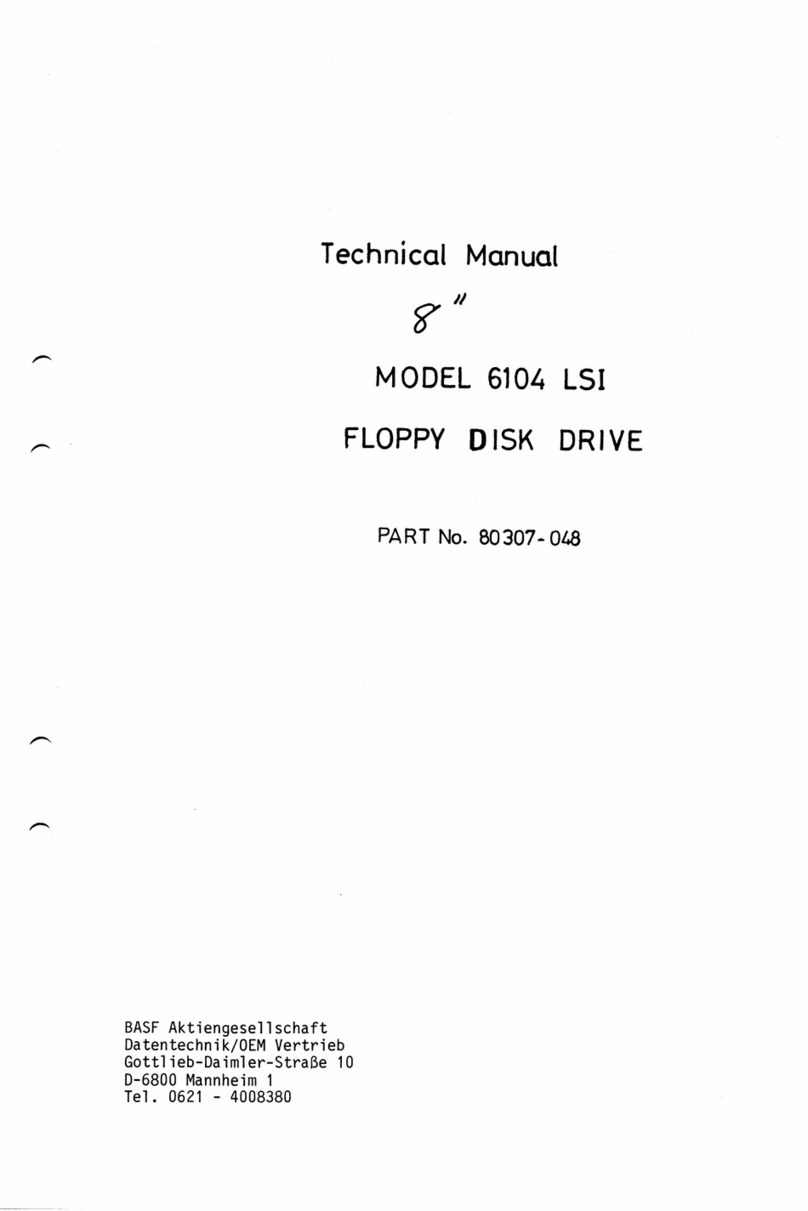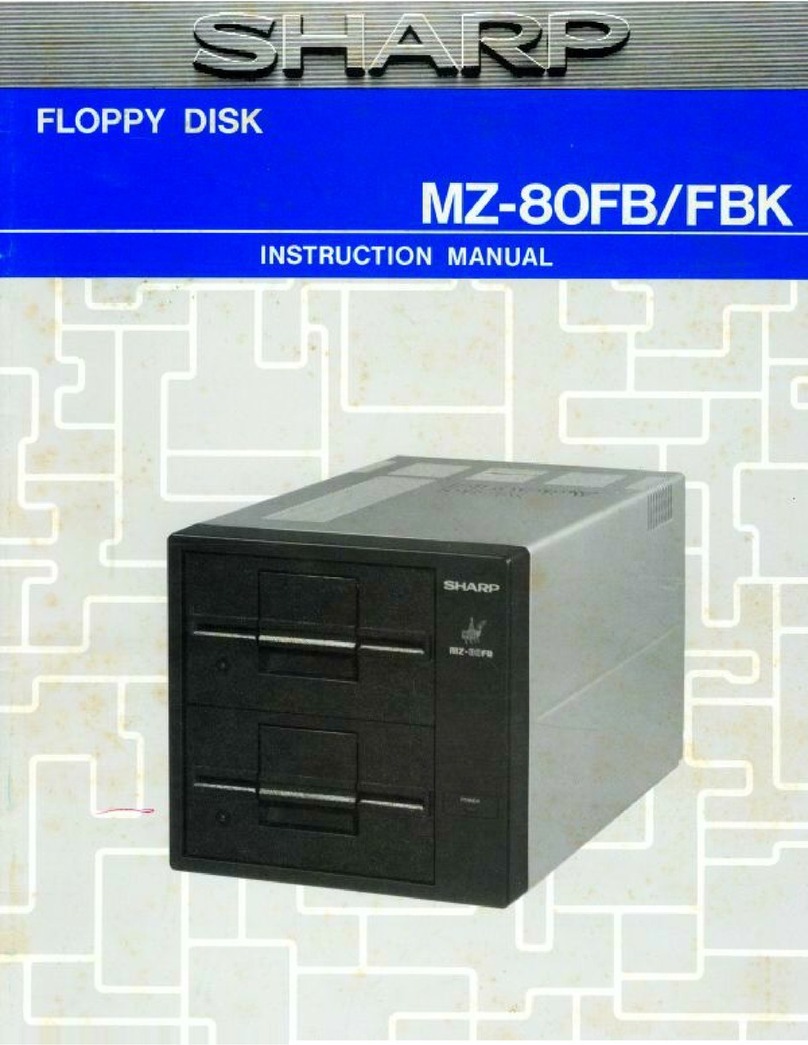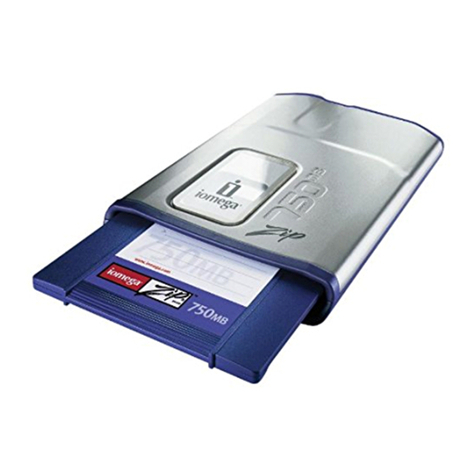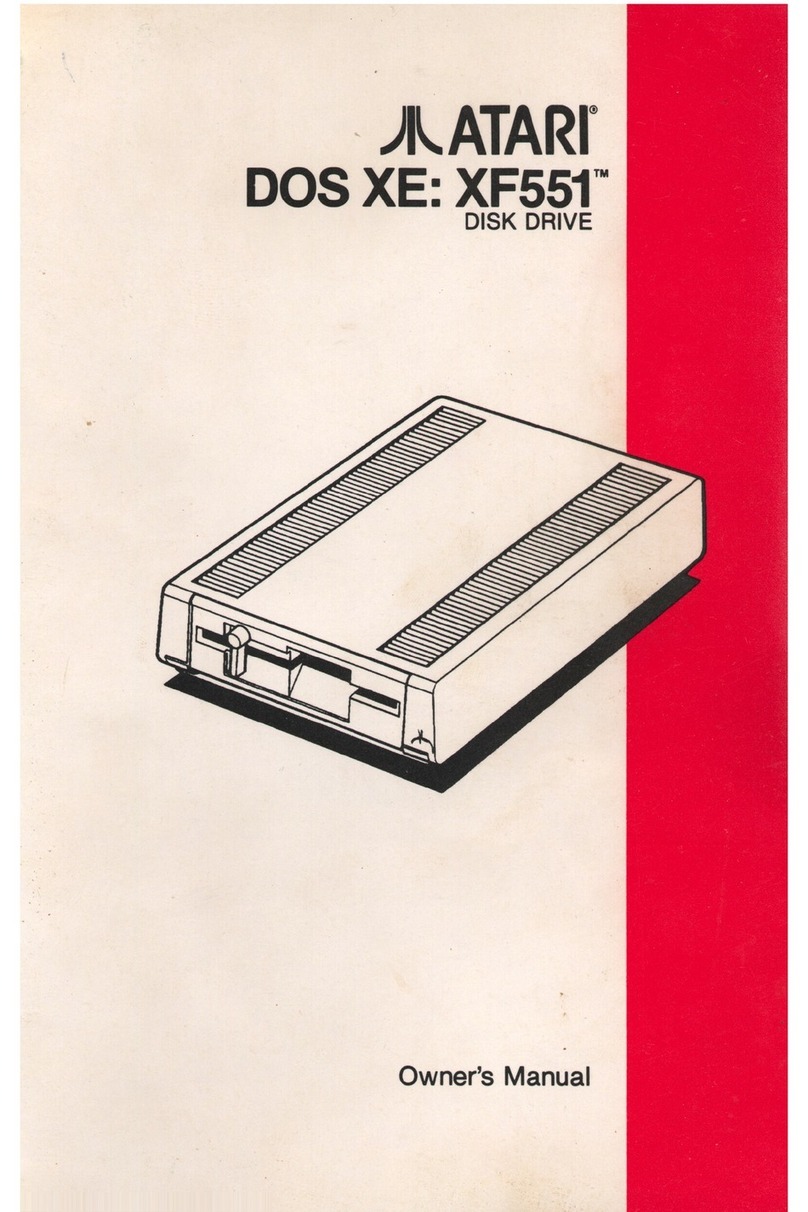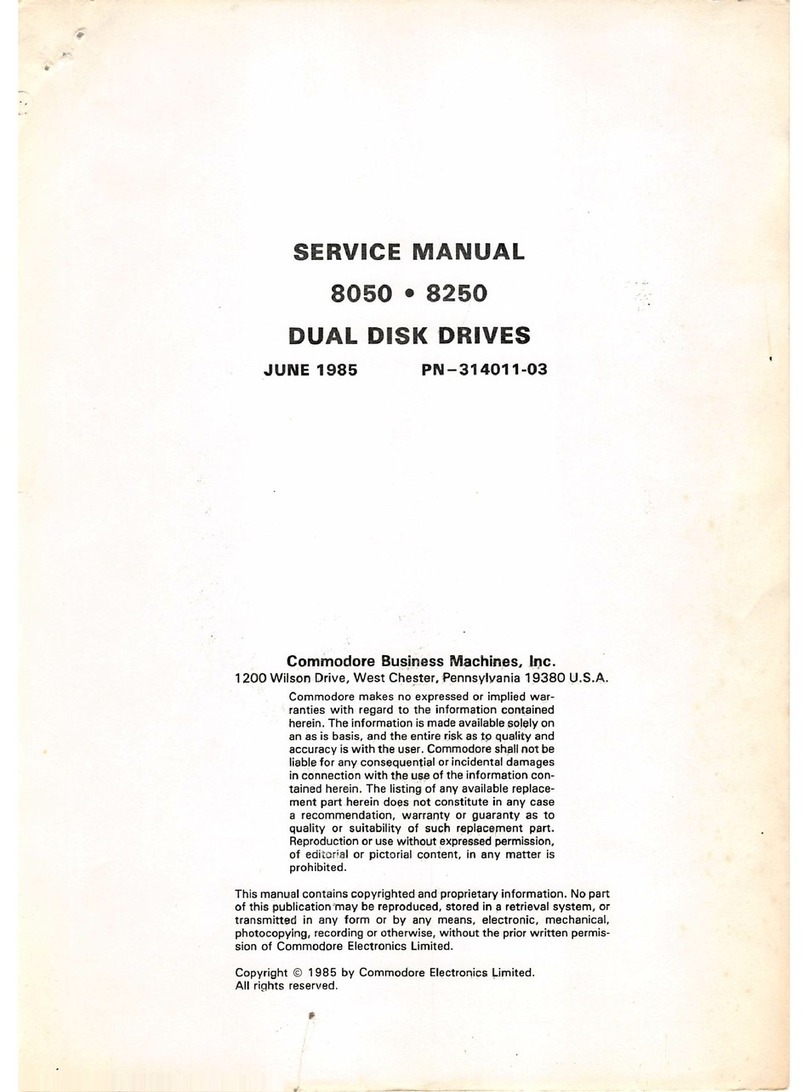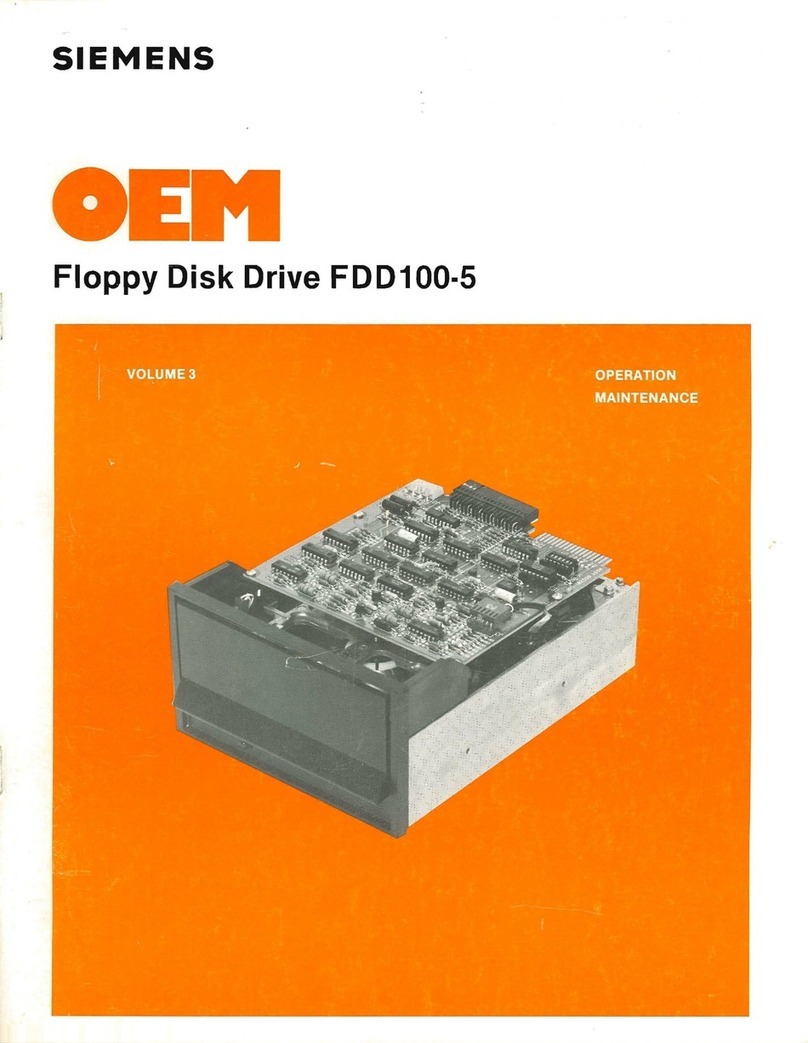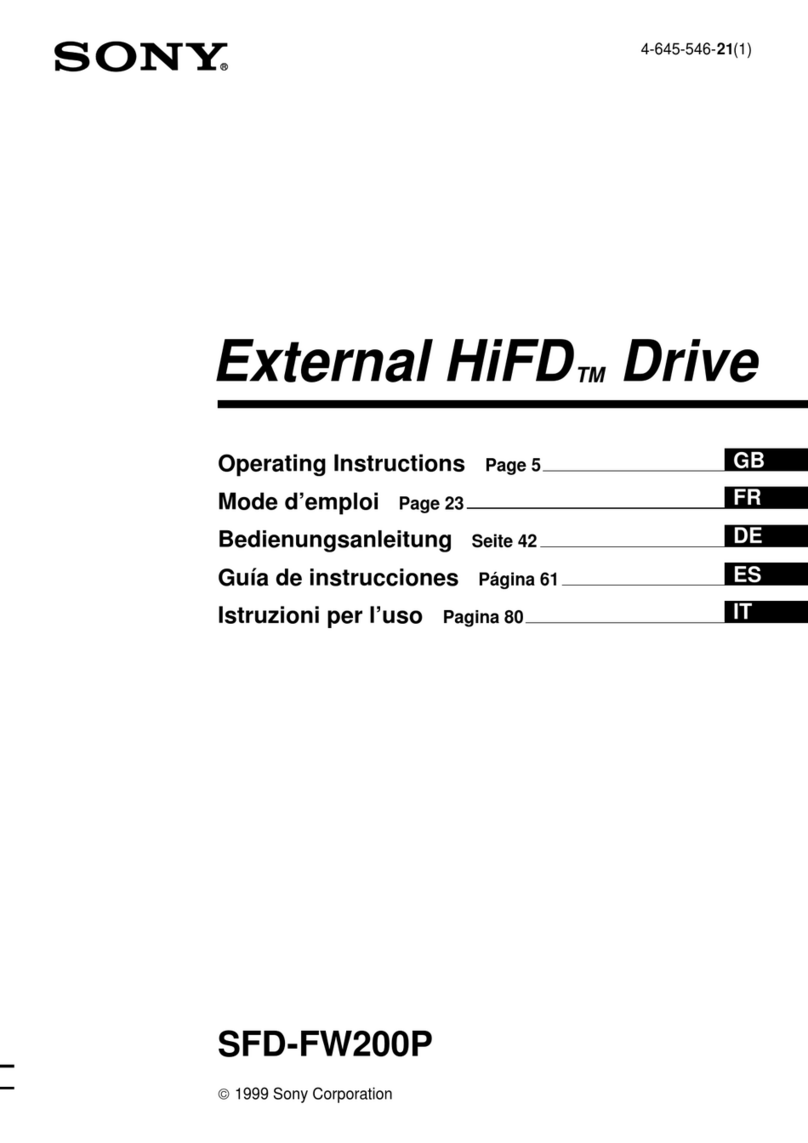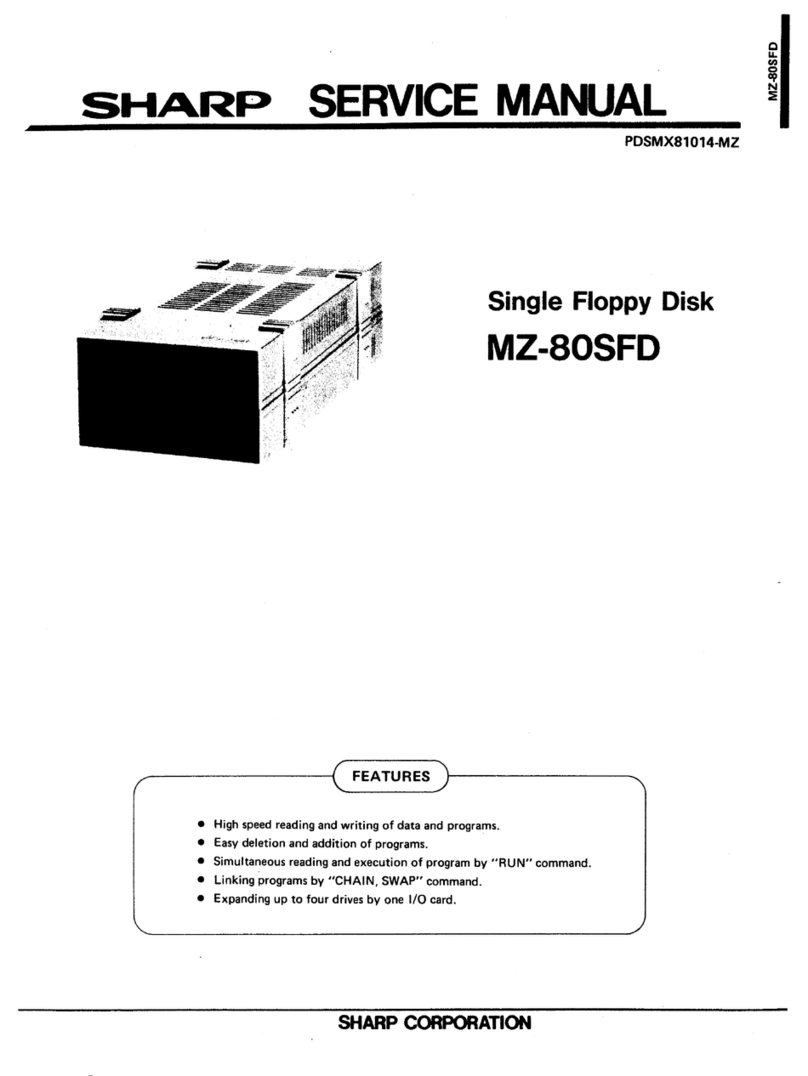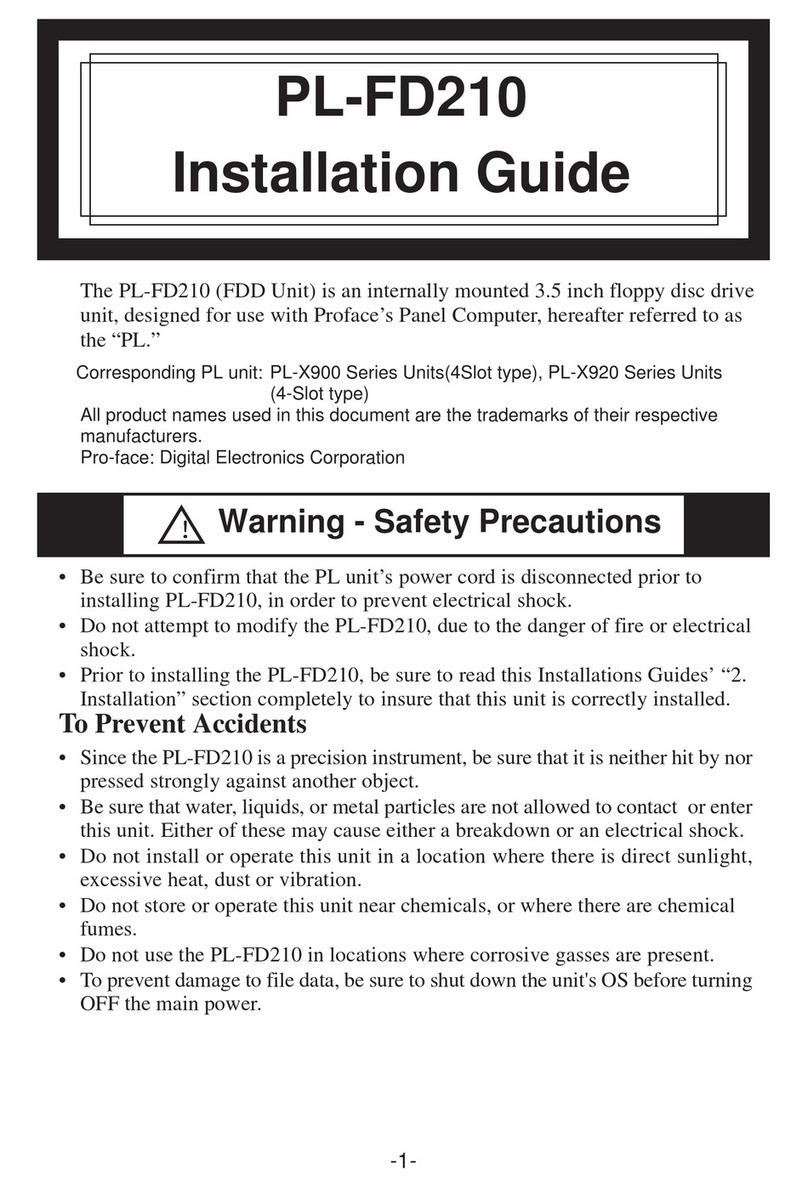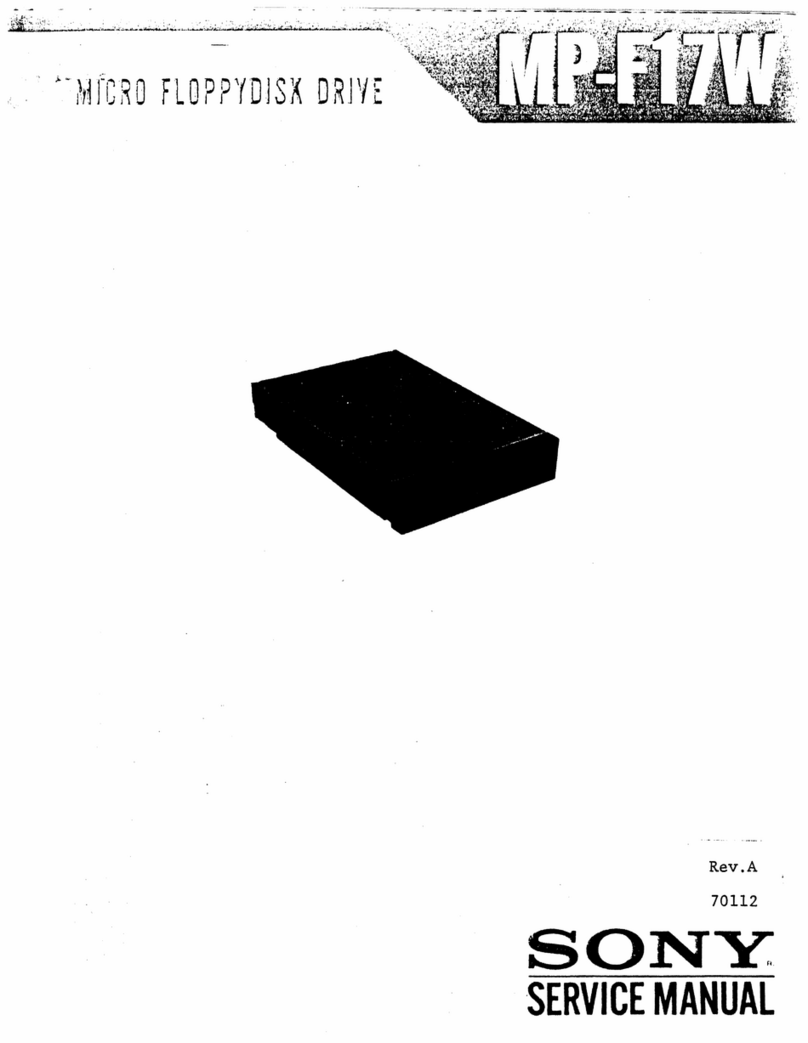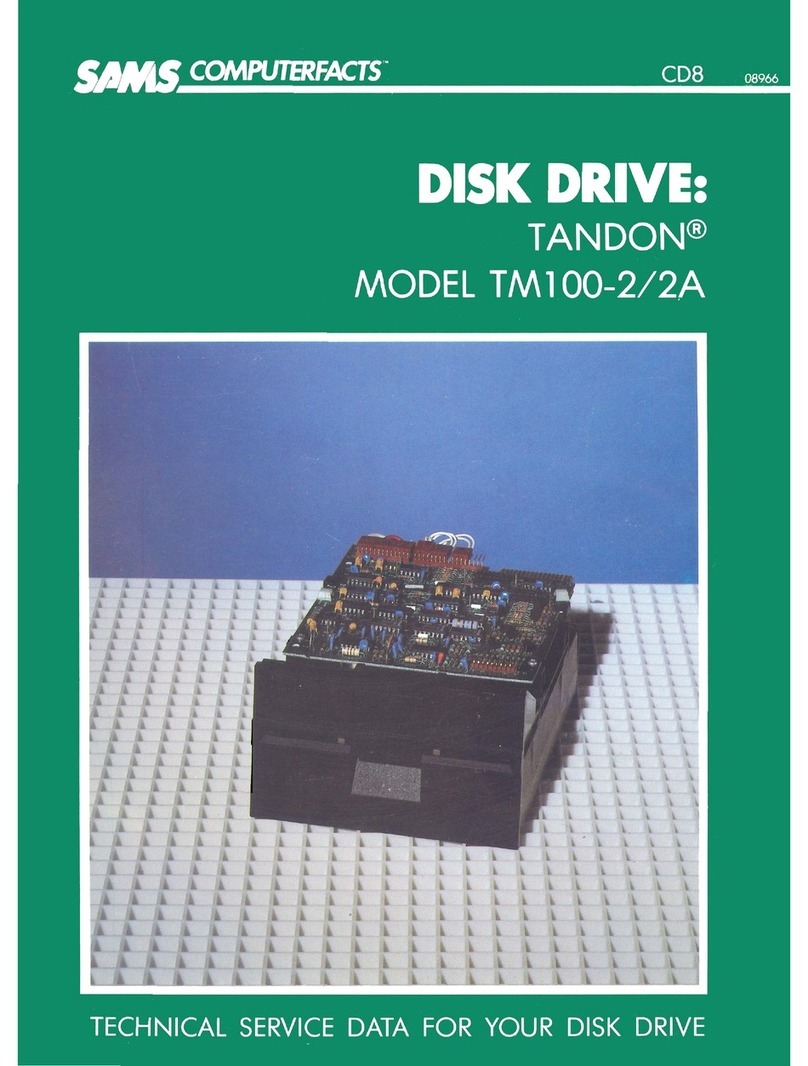BASF 6106 User manual


1,
REVISION
RECORD
OF
REVISION
REMARKS
'
01
VS
II Valid
for
SN
0000
-!-
0400
l
02
VS
III
Valid for
SN
0500
-/-
1300
03
VS
IV
Valid for
SN
2100
-/-
i
04
Corrections
05
Add.
Model
6108
Valid for Drives
with
PCB':\¥
88366
)
II

L I S T 0 F C 0 N T E N T S
SECTION
PAGE
SECT!
ON
PAGE
1.
INTRODUCTION
1-1
1.1 General 1-1
2.2.8
Type
of
Heads
2-20
1.2 Related Documentation 1-1
2.2.8.l
Read/Write
Head
2-20
l.J
Description 1-1
2.2.8.2
Side Select
Logic
2-21
1.4 Specification
Sulllllary
1-2
2.2.9
Write
Circuits
2-22
1.5
Opt
ions
Sulllllary
1-4
2.2.9.1
Write
Initiate
2-22
1. 5.1 Factory
Installed
Option 1-4
2.2.9.2
Write Logic 2-22
1.
5.
2
Jumper
Options 1-4
2.2.9.3
Erase
Delay
Logic
2-24
1.6 Recording
Media
1-5
2.2.lo
Read
Circuits
2-2
5
1.
7
Recording Formats 1-5
2.2.lo.1
Read
Initiate
and
Read
Block
2-2 5
1.
7.1
FM
Encoding
1-5
Diagram
1.
7.
2
MFM
Encoding
1-5
2.2.lo.2
Read/Write Select 2-2 6
1.8
Track
Format
1-6
2.2.lo.3
Read
Amplifiers
and
Filter
2-26
Network
1.8.1 Soft Sectored
Track
Formats 1-6
2.2.lo.4
Active
Differentiator
and
2-2 7
1.8.1.1
Soft Sectored
Track
Format
1-6 Comparator
for Single Density with
2.2.lo.5
Time
Domain
Filter
and
Crossover 2-27
16
Sectors/Track
a
128
Bytes Detector
1.8.1.2
Soft Sectored
Track
Format
1-9
2.2.lo.6
Timing
Diagram
Read
Circuits
2-28
for Single Density
(9
Sectors per
Track
a
256
Bytes) 2.2.11
DC-Control
and
Power
On
2-2 9
1.8.1.3
Soft Sectored
Track
Format
1-lo
Reset Logic
for
Double
Density 2.2.11.1
DC-Control
2-2 9
(16
Sectors per
Track
a
256
Bytes) 2.2.11.2
Power
On
Reset
Logic
2-2
9
2.
THEORY
OF
OPERATION
2-1
2.1 Functional Description
2-1
2.1.1 Drive
Mechanism
2-2
2
.1.2
Spindle
and
Front
Door
Mechanism
2-2
2.1.3
Positioning
Mechanism
2-3
2.1.4
Head
Load
Mechanism
2-4
2.2
Logic
Description 2-5
2.2.1
Interface
Logic
2-5
2.2.1.1
Input
Interface
2-6
2.2.1.2
Output
Interface
2-6
2.2.1.3
Jumper
Options 2-7
2.2.2
Stepper
Motor
Control 2-12
2.2.3
Drive
Motor
Control
2-14
2.2.4
Head
Load
Logic
2-15
2.2.5
Track
Zero
Detector 2-16
2.2.6
Write Protect Detector 2-17
2.2.7 Index/Sector-
and
Ready
Detector 2-18
2.2.7.1
Index/Sector Detection 2-18
2.2.7.2
Ready
Detection 2-19
III

t
L I S T 0 F C 0 NT E NT S
)
SECTION
PAGE
SECTION
PAGE
3.
INSTALLATION
AND
OPERATION
3-1
4.3.2.l
Drive
Motor
and
Drive Belt
4-2
3.1
Installation
3-1
Checks
3.1.1
General
3-1
4.3.2.2 Drive Belt Tension
Check
4-2
3.1.2
Unpacking
and
Inspection
3-1
4.3.2.3
Drive
Belt
Replacement
and
4-3
Tension
Adjustment
3.1.3 Connecting Cables 3-2 4.3.2.4 Drive
Motor
Speed
Check
4-3
3.1.4 Connectors
3-2
4.3.2.5 Drive
Motor
Speed
Adjustment
4-3
3.1.4.l
DC-Connector
3-2 4.3.2.6
Drive
Motor
Speed
Adjustment
4-4
3.1.4.2 Signal Connector
3-2
using a
Frequency
Counter
3.1.4.3
Frame
Connector
3-2
4.3.2.7 Drive
Motor
Replacement
4-4
3.1.4.4 Interconnecting
Diagram
3-2
4.3.3 Positioning
System
4-5
3.1.5
Logic
Levels
and
Termination 3-4 4.3.3.1
Track
Adjustment
Check
4-5
3.1.6 Connecting Configuration 3-4 4.3.3.2
Track
Adjustment
Procedure
4-6
3.1.6.l
Single
Drive
Configuration 3-4 4.3.3.3 Adjustment
Check
for Optical
4-7
3.1.6.2 Multiple
Drive
Configuration 3-4
Track
Zero
Switch
3.1.7 Selection of the Desired
Option
3-6 4.3.3.5
Track
Zero
Switch
Replacement
4-8
3.1.7.1 Selection Options 3-6 4.3.3.6
Head
Carriage
Replacement
4-9
3.1.7.2
Head
Load
Options 3-6 4.3.3.7
Head
Load
Pad
Replacement
(6106)
4-9
3.1.7.3
In
Use
I
Disk
Change
Option
3-6
4.3.4
Head
Load
Mechanism
4-10
3.1.7.4
Door
Lock
Options 3-6 4.3.4.1
Head
Load
Solenoid
Replacement
4-10
3.1.7.5 Activity
LED
Options
3-7
4.3.4.2
Head
Load
Actuator
Check
4-10
3.1.7.6
Write
Protect
Option
3-7
4.3.5 Read/Write Electronics
4-11
3.1.7.7 Stepper
Motor
Switching
3-7
4.3.5.l
Jitter
Check
and
Adjustment
4-11
3.1.7.8
Jumper
Matrix 3-8 4.3.5.2
Read
Amplitude
Check
4-11
3.1.8
Drive
Mounting
3-10 4.3.6
Photo
Transistors
and
LED's
4-12
3.1.8.1
Mounting
Positions 3-10
4.3.6.l
Photo
Transistor
Replacement
4-12
3.1.8.2
Mounting
Dimensions
3-10
4.3.6.2
LED-Replacement
4-12
3.2 Operation
3-11
4.3.6.3
Index
Detector
Adjustment
Check
4-12
3.2.1
General
3-11
4.3.6.4
Index
Detector
Adjustment
4-13
3.2.2
Mini
Disk
Storage
and
Handling
3-11
4.4 Location of Testpoints, IC's,
4-14
Potentiomenters
and
Connectors
3.2.3 Write Protect
3-12
3.2.3.l
Write Protect
if
notch
open
3-12
(optional)
3.2.3.2
Write
Protect
if
notch covered
3-12
5. Spare Parts
I
(ECMA)
5.1
Attachment
1,
Spare
Parts for
BASF
6106
5.2
Attachment
2, Spare Parts for
BASF
6108
4.
MAINTENANCE
4-1
4.1
General
4-1
>
------
4.2 Tools
and
Test
Equipment
4-1
4.3
Checks,
Adjustment
and
4-2
Replacements
4.3.l
PCB
Replacement
4-2
4.3.2 Spindle Drive
System
4-2
IV

FIGURE
1 - 1
1 - 2
1 - 3
1 - 4
1 - 5
l - 6
1 - 7
1 - 8
1 - 9
2 - 1
2 - 2
2 - 3
2 - 4
a
2 - 4 b
2 - 5 a
2 - 5 b
2 - 6
2 - 7
2 - 8
2 - 9
2 -
lo
2 -
11
2 -
12
2 -
13
2 -
14
2 -
15
2 -
16
2 -
17
2 -
18
2 -
19
2 -
2o
2 -
21
2 -
22
2 -
23
2 -
24
2 -
25
2 -
26
2 -
27
2 -
28
2 -
29
L I S T
0 F
I L L
U
S T R A T I
0
N S
Model
BASF
6106/6108
Mini-Disk-Drive
Flexible
Disk
Construction
and
Dimensions
FM-Encoding
MFM-Enrodi
ng
Address
Mark
Patterns
Soft Sectored
Track
Format
with
16
Sectors per
Track
Simplified
EDC
Shift
Register
Soft Sectored
Track
Format
with 9 Sectors per
Track
Soft Sectored
Track
Format
for
Double
Density
(MFM)
PAGE
1-1
1-5
1-5
1-5
1-6
1-7
1-8
1-9
1-lo
Block
Diagram
BASF
6lo6/6lo8 2-1
Drive
Mechanism
2-2
Spindle
and
Front
Door
Mechanism
2-2
Positioning
Mechanism
6106
Positioning
Mechanism
6108
Head
Load
Mechanism
6106
Head
Load
Mechanism
6108
Interface
Logic
Auto
Select
Option
Radial Select Option
Auto
Head
Load
Option
Selected
Head
Load
Option
Radial
Head
Load
Option
Door
Lock
Latch Option
Timing
Diagram
Door
Lock
Latch Option
Disk
Change
Logic
Timing
Diagram
Disk
Change
Logic
Stepper
Motor
Control
Stepper
Motor
Timing
Diagram
Drive
Motor
Control
Head
Load
Circuit
Door
Lock
Solenoid
and
Activity
LED
Driver
Head
Load
Timing
Diagram
Track
Zero
Detector
Track
Zero
Timing
Diagram
Write
Protect
Detector
Index
Detector
Ready
Detector
Ready
Timing
Track
Geometry
Electrical
Connection of the
Read/Write
Head
Side Select Logic
2-3
2-3
2-4
2-4
2-5
2-7
2-7
2-8
2-8
2-8
2-9
2-9
2-11
2-11
2-13
2-13
2-14
2-15
2-15
2-16
2-16
2-17
2-18
2-lg
2-19
2-20
2-20
2-21
v
FIGURE
2 -
3o
Write
Initiate
Timing
2 -
31
a Simplified Write Circuits
6106/6108
2 -
31
b
Timing
Diagram
Write Operation
(Simplified)
2 -
32
2 -
33
2 -
34
2 -
35
2 -
36
2 -
37
2 -
38
Erase
Delay
Logic
Erase
Delay
Timing
Read
Circuits 6106/6108
(Simplified)
Read
Initiate
Timing
Read/Write
Select
Logic
Read
Amplifiers
and
Filter
Network
Active
Differentiator
and
Comparator
PAGE
2-22
2-22
2-2
3
2-2
3
2-24
2-2 4
2-2
5
2-2
~
2-26
2-2
7
2 -
39
Time
Domain
Filter
and
Crossover 2-28
Detector
2 -
4o
2 -
41
2 -
42
2 -
43
3 - 1
3 - 2
3 - 3
3 - 4
3 - 5
3 - 6
3 - 7
3 - 8
3 - 9
3 -
lo
3 -
11
3 -
12
3 -
13
5 - 1
5 - 2
Timing
Diagram
Read
Circuits
2-28
DC-Control
Logic
2-29
Power
On
Reset
Logic
Timing
Diagram
Power
On
Reset
Shipping Configuration
DC-Connector
Interconnecting
Diagram
Interface
Logic Levels
Recommended
Driver/Receiver
Circuit
Single Drive Configuration
Radial Select Configuration
Daisy
Chain
Select Configuration
Part Locations {Principal)
Mounting
Specification
Flexy
Disk
Loading
Write Protect Feature
(ECMA)
Write Protect Feature (optionJI)
Parts
Breakdown
6106
Parts
Breakdown
61o8
2-2 g
2-2
9
3-1
3-2
3-3
3-4
3-4
3-4
3-5
3-5
3-9
3-lo
3-11
3;;ll2
3-12
5-2
5-3

L I S T 0 F T AB L E S
TABLE
PAGE
1 -
1 Specification
SulllTiary
1-2
1 -
2 Factory
Installed
Option 1-4
l - 3
Jumper
Selectable Options 1-4
2 - 1 Input Signals 2-6
2 - 2 Output Signals 2-6
2 - 3 Write Protect Jumpering 2-9
2 - 4
Sequence
of the Stepper
Motor
2-12
Signals
3 - 1
DC-Power
Requirements 3-2
3 - 2
Reconmended
Jl
Mating
Connectors 3-2
3 - 3 Select Options Jumpering 3-6
3 -
4
Head
Load
Option Jumpering 3-6
3 - 5
In
Use
Disk
Change
Option 3-6
Jumpering
3 - 6
Door
Lock
Options Jumpering 3-6
3 - 7 Activity
LEO-Option
Jumpering 3-7
3 - 8 Write Protect Option Jumpering 3-7
3 - 9 Stepper
Motor
Switching Option 3-7
Jumpering
3 - lo Option
Jumper
Matrix 3-8
3 -
11
Flexy
Disk
Loading
3-11
3 -
12
Flexy
Disk
Unloading
3-11
4 - 1 Standard Tools
and
Test 4-1
Equipment
4 -
2 Special Tools
and
Test 4-1
Equipment
5 - l Spare Parts
BASF
6106
5-4
5 - 2 Spare Parts
BASF
6108
5-7
5
-3
R/W
PCB-88356
5-10
5 - 4
R/W
PCB-88366
5-13
VI

(
SECTION
1
INTRODUCTION
1.1
GENERAL
This
manual
contains descriptive material
and
procedures useful in
installation,
operation,
maintenance
and
repair of the
BASF
Mini
Disk
Drive
Models
BASF
6106
and
BASF
6108.
1.2
RELATED
DOCUMENTATION
Product-
and
Interface Specification
BASF
6106/6108
So
3o7-o46
1.3
DESCRIPTION
The
models
BASF
6106
and
BASF
6108
are
very
compact
random
access data storage units.
which
utilize
a
5.
25"
Flexy
Disk
as
storage
medium.
The
BASF
6106
stores data
on
one
side of the
Flexy
Disk,
the
BASF
6108
on
both
sides.
The
Flexy
Disk
is
rotated
at
300
RPM
yielding
a data
transfer
rate
of
125~000
bits
per
second
in single density.
Up
to
125
kbytes
of
raw
data
may
be
stored
on
a single recording surface in
single density,
and
twice
as
much
in
double
density.
Data
capacity
on
all
4o
tracks varies
from
81.92 kbytes
(BASF
6106,
16
sectors
at
128
bytes)
to
368.64
kbytes,
so
increasing capacity
more
then four times
by
using the
BASF
6108
with
9 sectors of
512
bytes each.
The
mini
disk drives are
equipped
with a
DC-
controlled spindle drive
motor,
thus
no
AC-Power
is
needed.
Ceramic
read/write
heads
with
tunnel
erase are
used
with·in
the
BASF
6106/6108
to ensure
reliable
data recording.
The
heads
are positioned with a fourphase
DC-
stepper
motor
actuator.
utilizing
a spiral
wheel
which
provides precise location of the read/write
head
or
heads
on
the track.
Applications for
both
types of
mini
disk drives
comprise
word
processing
and
text
editing systems,
program
storage for
mini
and
micro
computers.
"intelligent"
desktop calculators
and
the
hobby
micro
computer
market.
FIGURE
l - 1
MODEL
';!ASF
61o6/6lo8
MINI
DISK
DRIVE
1 - 1

1.4
SPECIFICATION
SUMMARY
Acomprehensive
list
of principal specifications for
model
BASF
6106
and
model
BASF
6lo8
is
provided
in
table 1 -
1.
P E R F 0 R MA NC E S P E C I F I C AT I 0 NS
CAPACITY
BASF
6106
(single sided)
Unformatted
Single Density
per
Disk
125
kilobytes
per Surface
125
kilobytes
per
Track
J.125 kilobytes
Formatted
(16
Sectors/Track)
per
Disk
per Surf
ace
per
Track
per Sector
TRANSFER
RATE
LATENCY
Maximum
Average
ACCESS
TIME
81.920 kbytes
81.
920
kbytes
2.048 kbytes
128
bytes
125
kilobits/s
200
ms
loo
ms
Track
to
track positioning
12
ms
Average
Settling
Time
Head
Load
Time
240
ms
max.
48
ms
max.
35
ms
Drive
Motor
Start
Time
max.65o
ms
Double
Density
250
kilobytes
250
kilobytes
6.250 kilobytes
16J.84o kbytes
16J.84o kbytes
4.o96 kbytes
256
bytes
250
kilobits/s
F·U
tt
C T I 0 NAL S P E C I F I C AT I 0 NS
BASF
6108
(double sided)
Single Density
Double
Density
250
kilobytes
500
kilobytes
125
kilobytes
250
kilobytes
J.125 kilobytes
6.
25
kilobytes
16J.84o kbytes J27.68o kbytes
81.920 kbytes
163.840
kbytes
2.o48 kbytes 4.o96 kbytes
128
bytes
256
bytes
125
k
ilobits/s
250
kilobits/s
BASF
6106
BASF
6108
Single Density
Rotational
Speed
300
RPM!
2,5 %
Recording Density
( inside Track)
3979
BPRAD
(2768
BPI)
Flux
Density
7958
FTPRAD
(5536
FCI)
Track
Density
48
TPI
Track
Radius
Track
00
57,15
nm
Track
39
36.5125
nm
Encoding
Method
FM
Media
Requirements
BASF
Flexy
Disk
5.25"-l
+)
On
Side
l,
Side 0 see
6106
Track
radius 1 is
2.
1167
nm
smaller then track radius
O.
Double
Density Single Density
Double
Density
Joo
RPM
! 2,5 %
Joo
RPM
! 2,5 %
Joo
RPM!
2,5 %
7958
BPRAD
3979
BPRAD
7958
BPRAD
(5536
BPI)
(2768
BPI)
(5536
BPI)
7958
FTPRAD
7958
FTRAD
7958
FTPRAD
(5536
FCI)
(5536
FCI)
(5536
FCI)
48
TPI
48
TPI
48
TPI
+) +)
57,15
nm
55,o3
11111
+)
55,o3
11111
+)
J6.5125
nm
34.3958
nm
34.3958
nm
MFM
FM
MFM
BASF
Flexy
Disk
BASF
Flexy
Disk
BASF
Flexy
Disk
5.25"-lD 5.25"-2 5.25"-20
lABLE
1 - 1
SPECIFICATION
SUMMARY
(continued)
1 - 2

(
P HY S I C A L S P E C I F I C AT I 0 NS
Environmental limits
Ambient
temperature
on
disk surface (operation)
Relative humidity
Maximum
wet
bulb
DC-voltage
requirements
Power
dissipation
Mechanical
dimensions:
Width
Height
Depth
Weight
R E L I AB I L I T Y
MTBF
Unit
life
time
MTTR
Error
rates:
Soft read errors
Hard
read errors
Seek
errors
S P E C I F I C AT I 0 NS
ME DI A S P E C I F I CAT I 0 NS
10°
to
So
0c
(So°F
to
12o°F)
2o
%to
Bo
%
29°c
(B4°F)
+
12
voe
.:!:.
s
,;
max.
loo
mVpp
ripple
+ s
voe
+ s
,;
o,S A
max.
So
mVpp
ripple
+)
motor
starting
current
max.
o.65 Afor
max.
So
msec
head
load
start
current
o.7 Afor
So
msec
lo.o
Watts
operating
4.o
Watts
stand
by
(motor
off)
7.5
Watts
motor
on
and
deselected
146.1
11111
(S.75 inch)
S3.S
11111
(2.11 inch)
190.0
11111
(7.48 inch)
1.4
kg
10000
POH
under
typical
usage+)
S years
3o
minutes
1 per
10
8
bits
read
1 per
loll
bits
read
1 per
106
seeks
+)
Duty
cycle of Spindle
Drive
Motor:
£0%
of
POH
Jacket 133.3
11111
(5.25 inch) square
Disk
l3o.2
11111
(5.125 inch) diameter
Center hole 28.57
11111
(1.125 inch) diameter
TABLE
1 - 1
SPECIFICATION
SUMMARY
1 - 3

1.5
OPTIONS
SUlltlARY
The
following tables
list
the options of the
BASF
6106
and.
BASF
6108
Mini
Disk
Drives.
1.5.1
FACTORY
INSTALLED
OPTION
Option
Function
Door
Lock
Locks
the font
door
under
Solenoid control of the users
soft-
ware.
TABLE
1 - 2
FACTORY
INSTALLED
OPTION
1.5.2
JUMPER
OPTIONS
The
following options are selectable
by
jumpers
on
the
PCB.
Refer to Table 3 - lo for
jumper
option matrix.
Option
RADIAL
SELECT
AUTO
SELECT
HEAD
LOAD
IN
USE
Function
Allows
the connection of
three
mini
disk drives to
the host system.
Each
drive
has
its
own
address (0,1,2)
selectable
by
jumper.
The
interface
is
always
enabled (drive
is
always
selected).
The
SELECT-lines
are not
used.
Loading
of the
head
can
be
accomplished
in
three
modes:
• Selected
Head
Load
(INT.SELECT•
HEAD
LOAD)
•
Auto
Head
Load
(INT.
SELECT)
• Radial
Head
Load
(HEAD
LOAD)
The
head
will
be
loaded only
if
the inserted
mini
disk
rotates.
Pin
34
of the interface
is
used
as
IN
USE
input signal
and
controls the
door
lock
solenoid
and
the
activity
indicator.
If
this
option
is
used
the
disk
change
option
must
be
disabled.
Option
DOOR
LOCK
LATCH
DISK
CHANGE
ODOR
LOCK
ACTIVITY
INDICATOR
OPTIONS
WRITE
PROTECT
OPTION
STEPPER
MOTOR
SWITCHING
Function
Allows
locking of the
door
withoui maintaining the
IN
USE
signal activated
by
storing the
state
of the
IN
USE-signal
into the
IN
USE-
flipflop.
To
use
this
option
the
IN
USE-option
must
be
jumpered.
Notifies the host system
that the
mini
disk
has
been
changed.
If
this
option is
used, the
IN
USE-option
must
be
disabled.
Locking
of the
door
can
be
accomplished
as
follows:
1.
by
the
IN
USE-signal
2.
by
the
IN
USE-FF
(DOOR
LOCK
LATCH)
3.
if
the drive
is
selected
(I/D
ENA
activ)
4.
if
the
head
will
be
loaded
(HDLOADENA
activ)
5.
if
1. or 3.
is
true
6.
if
1.
or 2. or 3.
is
true
7.
if
1. or 4.
is
true
8.
if
1. or
2.
or 4.
is
true
The
lighting of the
activity
LED
is
selectable
by
jumper
to
one
of the following
conditions :
• the
head
is
loaded
and
the
drive
is
ready
• the
door
is
locked
and
the
drive
is
ready
Allows
protection of the
mini
disk against overwrite
if
the write protect notch
is
closed
(ECMA,
Shugart).
The
stepper
motor
is
switched
on
and
oft
together with the
drive
motor
if
a
jumper
is
in-
serted.
If
the
jumper
is
not
inserted, the stepper
motor
will
be
enabled
as
long
as
power
is
supplied.
TABLE
1 - 3
JUMPER
SELECTABLE
OPTIONS
1 - 4
)

1.6
RECORDING
MEDIA
The
BASF
mini
disk drives
use
a removable
130
11111
(5.25 inch) diameter
flexible
disk
as
storage media. Fig. 1-2
shows
·construction
and
dimensions of a
typical
5.25" Flexy Disk.
The
rec011111ended
recording
media
is:
for
model
BASF
6106
mini
disk drives:
single
density:
double density: 5.25"-1
5.25"-l
D
for
model
BASF
6108
mini
disk
drives:
single
density:
double density: 5.25"-2
5.25"-2 D
The
Flexy
Disk
is
an
oxide coated
flexible
disk enclosed in a
protective
plastic
envelope.
The
protective
envelope contains
apertures
for
head
contact,
index
detection,
write
protect
detection
and
drive spindle
loading.
The
write
protect
notch
is
used
to
protect
the
written
data
on
the Flexy
Disk
(see
2.2.6
Write Protect Detector).
St:ALEll
t'Kon;cT1
Vt:
.IACKE'I'
MYLAR
DlSK
TRACK
00
FIG.
1 - 2
SI' I
NOLE./
111111
,\cn:ss
---
.......
........
O
/\..;
------;.~-lNDE.X/
SECTOR
llOLE
-
LINER
/
/
FLEXIBLE
DISK
CONSTRUCTION
AND
DIMENSIONS
lNDEX
HOLE
TRACK
39
1 - 5
1.7
RECORDING
FORMATS
The
format of the data recorded
on
the
diskette
depends
on
the host system. There are
two
encoding
schemes
used:
•
FM
(Frequency
Modu
1
ation)
for
single
density
•
MFM
(Modified Frequency Modulation)
for double density.
1.7.1
FM-ENCODING
This
scheme
utilizes
clocks
to
define
bit
cell
times.
The
presence of a flux reversal
between
clock pulses
is
defined
as
a
"one"
bit.
The
absence of a flux reversal
between
clocks
is
defined
as
a "zero"
bit.
On
the write data
and
read data
interface
lines
between
disk drive
and
host system every pulse represents a flux
re-
versal
on
the
diskette.
8µsec
Bl
TC
ELL
~-r-
' i
DATA
I,,,
11
I
0 I,I0 I0 I0 I,I
I I I
I
I I I I I I
I I I
-jSµst-
I I
I
I
I
1
j4µ~1
I I I I I I I
I
1if:
I I I I I I
WRITE
DATA·······
••••
I
•••
CDCDCDC
CDC C C CDC
FIG.
1 - 3
FM-ENCODING
1.7.2
MFM-ENCODING
Aflux
transition
is
always
recorded
at
the center
of the
bitcell
for
each "one" data
bit.
No
flux
transition
is
recorded for a "zero"
bit
unless
it
is
not followed
by
another "zero"
bit.
In
this
case the flux
transition
is
provided
at
the
end
of the
first
bit
cell.
4
µsec
BITCELL
DATAl \h
tj
0
I]
I
0 I
0 I
0 I\ I
I I I I I I
I I I
f'
5
~iJS~
I I
I I I I I
-tl.J-151--
I
WRITE
DATA
I ' '
I '
ODD
OCCD
FIG.
1 - 4
MFM-ENCODING

1.8
TRACK
FORMAT
The
tracks of the Flexy
Disk
may
be
formatted
in
numerous
ways,
depending
on
the formatter
of the host system used.
The
BASF
mini
disk
drives write
and
read hard or
soft
sectored
track formats.
1.8.1
SOFT
SECTORED
TRACK
FORMATS
In
a
soft
sectored track format the user
may
record
one
long
record or several smaller
records
on
a track.
The
most
common
soft
sectored track formats are described in the
following chapters.
(The
designer should also consider national
and
international standards for data
inter-
change).
1.8.1.1
SOFT
SECTORED
TRACK
FORMAT
FOR
SINGLE
DENSITY
(16
sectors/track
a
12B
bytes)
This format
is
shown
in
Fig. 1-6.
It
is
similar
to
the
IBM-format.
The
beginr.ing of a track
is
indicated
by
a
physical
index
pulse.
Every
record
is
pre-
ceded
by
a unique record
identifier.
Record
identifiers
and
data
fields
are separated
by
gaps.
The
gaps
are necessary to allow updating
of a data
field
without disturbing adjacent
fields.
INDEX
GAP
This
gap
starts
with the index pulse
and
is
16
bytes in length.
It
is
not affected
by
any
update write process.
IDENTIFIER
GAP
This
gap
consists of
11
bytes
FF
and
may
vary
slightly
in
length
after
the data
field
has
been
updated.
DATA
GAP
This
gap
separates the data
field
from
the
following ID-field
and
is
nominally
27
bytes
in length.
It
will vary
slightly
in
length
after
the data
field
has
been
updated.
TRACK
GAP
The
gap
between
the
last
data
field
and
the
index
pulse
is
defined
as
Track
Gap.
It
varies
slightly
in length,
due
to
write frequency
and
disk speed
tolerances.
It
is
nominally
101
bytes in length.
ADDRESS
MARK
(AM)-BYTE
The
soft
sectored track
format
needs unique
bit
patterns to identify the beginning of
ID
and
Data
Fields for synchronizing the
deserializer
circuit
in the host system.
The
unique
bit
pattern
is
called
Address
Mark
(AM).
AM-patterns
do
not
contain clock
bits
in
all
bit
cells
(all
other
data bytes
must
have
clock
bits
in every
bit
cell!).
There
are three
different
AM-patterns
used:
e
ID-AM
e
DATA-AM
e
DELETED
DATA-AM
in front of
an
ID-Field
in front of a
Data
Field
in front of a Deleted
Data
Field
I
BYTE
ID
-
AM:
~c
6
cs
C4
s s
cl
·~s
I I
i1
...
" I I I I
SEP
CLOCK
(C7)
..
"
••
11
rn
07
1)6
05 04
03
n.i
8
SEP
DATA
(R)
I I I I I I I
DATA
-
AM:
I
Ir
C7
c6
C5
C4
C3
r,2
c,
f"
8
,
·e
I I
...
...
r1 I I I
I
SEP
CLOCK
(C7)
II
ti
,,
II
II
oa
07
06
05
I\
02
o,:
SEP
DATA
(FB)
••
I I I I I
1:
I
I
I
DELETED
DATA
-
At!:
I
t11
C7 ~
C5
G.
C3
~
Cl
1c
8
•
I
,,
,.,
n
I I I
•
S!P
CLOCK
(C7)
II
"
..
le
D9
n 7 D6
D5
D4
!IEP
DATA
(r8)
I
I I
I
I
FIG.
l - 5
ADDRESS
MARK
PATTERNS
1 - 6
)

(
SECTOR
IDENTIFIER
The
sector
identifier
consists of the
identifier
mark,
the address
identifier
and
the
EDC
pattern.
IDENTIFIER
MARK
This
field
comprises 7 bytes (see Fig. 1-6).
The
6 bytes of zeros in front of the address
mark
byte are for synchronisation of the data
separator
in
the host system.
The
ID-AM-byte
contains a data pattern of
FE
where
the clock
bits
C6,
CS
and
C4
are missing as explained
before.
ADDRESS
IDENTIFIER
The
address
identifier
comprises the following
6 bytes:
TRACK
ADDRESS
(TRK)
This byte represents in binary notation the
track address
from
00
for the outermost track
to
39
for the innermost track.
SIDE
ADDRESS
(SID)
Represents in binary notation the sioe address
(OO
or
01)
of the
mini
disk.
SECTOR
ADDRESS
(SEC)
Represents in binary notation the sector address
from
01
for the
1st
sector to
16
for the
last
sector
of
a track.
SECTOR
LENGTH
(LEN)
This byte
identifies
the length of the data
field
as
follows:
00:
128
bytes
01:
2S6
bytes
02:
S12
bytes
03:
lo24 bytes
EDC-BYTES
(EDC)
These
two
bytes are hardware generated
from
the
host system
by
shifting
serially
the
bits
of the
sector
identifier
starting
with the
ID-AM
and
ending
with the 4th byte of the sector
identifier
through
a 16-bit
shift
register
described
by
the generator
polynominal:
xl6 + xl2 +
XS+
l.
(For
more
details
read chapter EDC-implementation!)
NDEX
GAP
SECTOR
IDENTIYIER
IDENTIFIER
GAP
FIRST
DATA
BLOCK
DATA
BLOCK
GAP
LAST
DATA
BLOCK
DATA
BLOCK
GAP
TRACK
GAP
16
X
FF
13
BYTES
11
X
FF
137
BYTES
27
X
FF
137
BYTES
27
X
FF
IOI
X
FF
1st
:>ec:tor
.r--L
I!llDEX
PULSE
SECTOR
IDE~TIFIER:
ADDRESS
IDENTIFIER
E D C
TRK
SI
0
SEC
LEN
2
BYTES
'-v----'
ID-AH
DATA
BLOCK:
...__...._...,
DATA-AM
I)
DATA
PATTERN
2)
CLOCK
PATTERN
•
DELETED
AM
DATA
FIELD
I 2 8 II Y T E S
P8
ID
-
AM:
SEP
CLOCK
(C7)
SEP
DATA
(FE)
DATA -AM:
E D C
SEP
CLOCK
(C7)
2
llYTES
S!P
DATA
(PB)
DELETED DATA -
SEP
CLOCK
(C7)
SEP
DATA
(F8)
r,sc6
I
BYTE
cs
c•
s
I I n " " I
"
..
••
II
rD
0,
D6
DS
D4
8
I I I I I
I
le
,e
C7
c6
Cs
C4
C3
I I
,..
" " I
11
..
u
II
De
D7 D6
Ds
~
I I I I I
I
AH:
fa
C7
Cri
C5
Cti
C3
I I " " n I
..
!I
le
D9
D7
D6
Ds
D4
I I I I I
FIGURE
1 - 6
SOFT
SECTORED
TRACK
FORMAT
WITH
lE
SECTORS/TRACK
FOR
SINGLE
DENSITY
(FM)
1 - 7
s
r,
ls
I I I
D)
Di
I I
I
I
I
Cz
c,
~
8
I I I
Dz
D1:
I
1:
I
I
I
I
I
I
'"2
c,
•Cs
I I •

DATA
BLOCK
The
data block contains the data
mark,
the data
field
and
the
EDC-bytes.
DATA
MARK
This
field
comprises 7 bytes (see Fig. 1-6).
The
6 bytes of zeros in front of the data
address
mark
are for synchronisation of the
data separator
circuit
in the host system.
The
data address
mark
byte contains
FB
in front of
a
normal
data
field.
When
a deleted data
field
follows,
F8
must
be
written.
The
clock pattern
of the data address
mark
is
C7
(C6,
CS
and
C4
missing).
DATA
FIELD
This
field
comprises
128
bytes.
If
it
comprises
less
than
128
bytes, the remaining positions
shall
be
filled
with zeros.
EDC-BYTES
These
two
bytes are hardware generated
by
the
host system
by
shifting
serially
the
bits
of
the data block
starting
with the
Data-AM
and
ending with the
last
byte of the data
field
through a 16-bit
shift
register
described
by
the
following generator polynominal:
xl6
+
xl2
+
xs
+
1
EDC-IMPLEMENTATION
Fig. 1-7
is
a simplified logic of a
shift
register,
which
may
be
used
to generate the
EDC
bytes.
Prior to the operation,
all
positions of the
shift
register
are
set
to
ONE.
Input data are
added
(exclusive
OR)
to
the contents of position
c
1S of
the
register
to
form
a feedback. This feedback
in
turn
is
added
(exclusive
OR)
to
the contents of
position
c
4
and
position
c
11
.
On
shifting,
the outputs of the exclusive
OR
gates
are entered into positions
c
0,
Cs
and
c
12
respec-
tively.
After the
last
data
bit
was
added, the
register
is
shifted
once
more
as
specified above.
The
register
then contains the
EDC
bytes.
When
further
shifting
is
to take place during the writing
of the
EDC
bytes, the control signal
inhibits
ex-
clusive
OR
operations.
To
check
for
errors
when
reading, the data
bits
are
added
into the
shift
register
in exactly the
same
manner
as
they
were
during writing. After the
data the
EDC
bytes are also entered into the
shift
register
as
if
they
were
data. After the final
shift,
the
register
contents will
be
all
ZERO
if
the record
does
not contain
errors.
CONTROL
OUTPUT
for
EDC
writing
INPUT
FIGURE
l - 7
SIMPLIFIED
EDC
SHIFT
REGISTER
l - 8
)

I
(
1.8.1.2
SOFT
SECTORED
TRACK
FORMAT
FOR
SINGLE
DENSITY
(9
SECTORS/TRACK
i
256
BYTES)
In
this
format,
which
is
shown
in
Fig. 1-8,
each
sector contains
256
bytes.
I
1---------
lst
SECTOR
r--L
X + Y +Z • 204
BYTES
INDEX PULSE
SECTOR
IDESTIFIER:
ADDRESS
IDENTIFIER
E D C
TRK
SID
SEC
01 2
BYTES
DATA
BLOCK:
.....__,.......
DATA-AM
I)
DATA
PATTERN
2)
CLOCK
PATTERN
•
DELETED
AM
DATA
FIELD
E D C
2 5 6 B Y T E S 2
BYTES
Fe
256
YTES
(32+Y)
X
FF
9th
SECTOR
--1
ID
-
AM:
SEP
CLOCK
(C7)
SEP
DATA
(FE)
DATA
-
AM:
SEP
CLOCK
(C7)
SEP
DATA
(FB)
I
I
I
I I
I I
I
le
I e
C7
c6
C5
C4
I I
...
..
,,
1:
..
,,
If
Ir
De
D7 Db
Ds
I I I I
I
C3
I
rt.
I
Cz
I
Dz
I
c,
I
I
~e
I
DELETED
DATA
-
AM:
I
I
I
;a
C7
ct,
C5
Ct.
C3
0i
I I n n n I I
SEP
CLOCK
(
C7)
Cl
ICe
I •
De D 7
D6
D5
D4
SEP
DATA
(Fe)
I I I I I
FIGURE
1 - 8
SOFT
SECTORED
TRACK
FORMAT
WITH
9
SECTORS/TRACK
1 - 9

1.8.l.3
SOFT
SECTORED
FORMAT
FOR
DOUBLE
DENSITY
(16
Sectors a
256
bytes)
On
double sided
diskettes
for double density
track 0
on
side 0
is
recorded in
FM.
For
this
track only the previous described track
format for single density
is
valid.
All
other
tracks
on
the
diskette
are recorded in
MFM.
For
these tracks the following track format
will
be
valid (see Fig. 1-9).
The
content of the data blocks
is
doubled to
256
bytes.
In
MFM
recording the
bit
density
is
also doubled, the
sector
count will
be
the
same
as
in
single
density format (1.B.1.1).
The
meaning
of the
different
fields
arMl
the generation of the
EDC-bytes
are the
same
as
in single density re-
cording.
Only
the address
mark
pattern
is
changed
as
shown
in Fig. 1-9.
INDEX
GAP
SECTOR
IDENTIFIER IDENTIFIER
GAP
FIRST
DATA
BLOCK
DATA
BLOCK
GAP
LAST
DATA
BLOCK
DATA
BLOCK
GAP
TRACK
GAP
146BYTES
22
BYTES
22
• 4E
271.
BYTES 54
x
l.E
262 BYTES 54
x4E
192x4E
r---,
L-------------
---
--·
---
1st
SECTOR------------1
)--26th
SECTOR
_j
...J
l__
Ii
JDEX
-PULSE
INDEX
GAP
BO
x
l.E
12
•
oo
3 •
c2
11
J
Fe
J5o
.LE
11M15s1NG
CLOCK
TRANSITIONS
BETWEEN
B1Ts
s
AND 1..
w---,::::_-·
__
-
I
---
--
1
--
------
1
---
---
i---1
BYTE
----1
'
---
-----
I C2
I
C2
C2
---
FC
----
I
1
I , I
0
I
0
I
0
I
0
I , I
0
I
1
I
1
I
0
I
0
I
0
I
0
I
1
I
0
I
1
I,
I
0
I
0
I
0
I
0
I ,
1-;i
1
I , I
1
11
I
1
I
1
I
0
I
ril
INDEX
-AM
Ds
07
C5
c,
C3
D2
De
07
C5
c,
C3
D2
De
D1
C5
C4
C3
02
De
~
C\:,
°'
D:i
02
c,
Cs
I I I
n
I I I I I
n
I I I I I
n
I I I I I I I I I I
SECTOR
IDENTIFIER
IDENTIFIER
MARK ADDRESS IDENTIFIER E D C
12
x
00
3
x
A1 2)
FE
CYL
SID
SEC 01
7
BYTES
7)
MISSING
Cl
OCK
TRANSITIONS BE TWEEN
BITS
4
AND
3
ID-AM·
I
---~~------=-----
1
----:::--------
'
Al
A1
A1
---
1-'E
---:i
l110111010101011l1101110101n1:.11l110111010101011l111111111111110.
Os
05
Ci.
C3 C2
0,
Ds
05
Ci.
C3
C2
D,
De
D:-,
c,.
C3
Cz
Di
Os
D1
Cf;
Ds
Di.
D3
02
Ca
I I
1n1
II
I
l!:I
II
I
1n1
111111111
DATA BLOCK
DATA MARK DATA
FIELD
EDC
2)
MISSING CLOCK TRANSITIONS
BETWEEN
BITS
4
AND
3.
1)
DELFTFO
RF
CORD
FB
12K00
3xA1
21
FBJ)
255
BY
rES
2
BYTES
DATA
-AM
I
-------
1
----.
______
_
--
--
--
1
----
-----
1
A1
A1
A1
--
FB
----
I
110
t1
IOI
O
IO
IOl1!11Q
I 1
IO
IOIO
IO
I
1111oi
1
IO
IU
IO
I
0~
1111111I1101111
l
I
jDs
D5
C1.
C3
C2
D,
Os
Dr;
c,,
C3
r.7
Di
llfl
Dr)
c,,
C3
C7
o,
lltt
ll·;
llr,
05
111.
07
D1
11
I
I::
I I I I
In
I I I I I n I I I I I I I I I
I
l
I
I
DELETED
DATA-AM.
Al
A1
A1
FB
l110111010101011l110111010101011!110111010101011!11111111110101ol
Ds
I
FIGURE
l - 9
SOFT
SECTORED
TRACK
FORMAT
FOR
DOUBLE
DENSITY
(MFM)
1 -
lo

(
2.1
FUNCTIONAL
DESCRIPTION
The
models
6106
and
6108
comprise
the following
mechanisms
and
functional
circuits
(see Fig. 2 - 1). Functional Circuits:
•
Interface
•
Drive
Motor
Control
Mechanisms:
•
HEAD
LOAD-.
DOOR
LOCK-
and
ACTIVITY
LED-
Driver
•
Drive
Mechanism
•
Track
Zero
Detector
e
Spindle
and
Front
Door
Mechanism
•
Write
Protect Detector
• Positioning
Mechanism
•
Index
I
Ready
Detector
•
Head
Load
Mechanism
•
Read
I
Write Circuits
•
DC-
Control
and
Power
On
Reset
LOGIC
•
SIDE
SELECT
LOGIC
SELECT
11
....--
110
ENA
-
SELECT
21
WRITE
INHIBIT
SELECT
31
' I
-
t •
READ
READ/
DATA
I
WRITE
DATA/
WRITE
WR
T
CURRENT
or
RO
PLAYBACK
WRITE
GATE
I
CIRCUITS
ERASE
-
_
CURRENT
I
SIDE
S
IOE
SHH
Tl
I
SIDE
1
SELECT
0
N
LOGIC
u
p
I T
u p
T
PHASE
1 u
DIRECTION
STEPPER
'
T
~I
MOTOR
1
STEP/
CONTROL
4
INDEX
I
~Jl!n
~·
STEPPER
DOOR
LOCK
SENSOR
1
MOTOR
I
N
SOLENOID
\
1
N
T
(opt1onal1
~
ACTIVITY
,"'
~
T
E
I
LED\
~
£
R
I~
I~
~""'
R
F I
~~
t'"ll.1il
~r;i;
)\
ZERO
4
TRACK
F
A I
~
:'\
•
LIGHT-
A
TRACK
00/
(
DOOR
LOCK
DOOR
LOCK
~
~
BARRIER
t.r
..._
ZERO
'-
~
IN
USE
I
ENA
AND
""""
~
-..,
11.1ETECTOR
(
E
~-MOTOR
(oplion;il I
ACTIVITY
I
E
IUD
LOAD
DRIVER
R/W
HEAD
LOAD/
_
ENA
~HEAD___
HEAD
~
LOAD
,
DRIVER
HEAD
LOAD
SOLENOID
DRIVE
MOTOR
ON/
MOTOR
CONTROL
INDEX/
INDEX
I
INDEX
REA.DY
H
1
ADY
READY/
DETECTOR
DISK
WRT
+ERASE
CURRENT
CHANGE
I
--
I
Iopt1onall
WRITE
WRITE
•
sv
DC
Ul·
CONTROL
PWR
ON
RESFT
PROTECT
PROTECT/
•
12V
DC
ANO
DETECTOR
POWER
ON
RESET
..__
FIGURE
2 - 1
BLOCK·
DIAGRAM
BASF
6106/6108
2 - 1

2.1.1
DRIVE
MECHANISM
The
spindle
is
rotated at
300
rpm
by
a
DC
drive
motor. Rotation of the spindle
is
provided
by
a
belt
and
pulley.
The
drive
motor
is
started
and
stopped
by
the interface signal
MOTOR
ON.
The
ratio
between
motor
and
spindle speed
is
approximately 7:1.
The
drive
mechanism
is
shown
in Fig.
2 - 2.
2.1.2
SPINDLE
AND
FRONT
DOOR
MECHANISM
The
main
parts of
this
mechanism
are the drive
hub. the centering cone. the centering
cone
expander
and
the front
door
with pressure
arm
and
door
latch (see Fig. 2 - 3).
For
loading,
a
diskette
is
inserted
and
the front
door
pressed.
The
pressure
arm
moves
down.
the
centering
cone
enters the Flexy Disk. Just
before the centering
cone
reaches the
full
down
position,
the centering
cone
expander
is
FRONT
DOOR
(closed)------41r
DOOR
LATCH
DRIVE
MOTOR
SPINDLE
DRIVE
PULLEY
FIGURE
2 - 2
SPINDLE
DRIVE
HUB
DRIVE
MECHANISM
activated
and
expands
the centering
cone
which
grips
the inner diameter of the Flexy
Disk
to ensure correct
alignment.
The
door
latch
is
activated
and
holds the
front
door
in a closed position.
For
un.loading
a disk,
the front
door
must
be
pressed again.
The
door
latch
opens
and
the pressure
arm
is
moved
upwards
by
a spring.
The
centering
cone
and
centering
cone
expander also
move
upwards
and
disengage the
mini
disk
from
the drive
hub.
CENTERING
CONE
EXPA.\DER
CO:\E
PRESSURE
ARM
DRIVE
Hl'B
? -2

2.1.4
HEAD
LOAD
MECHANISM
The
head
load
mechanism
comprises
(see Fig. 2 - 5):
•
Head
Load
Solenoid
•
Head
Load
Actuator
HEAD
LOAD
PRESSURE
ARM
R/W
HEAD
HE
AO
LOAD
PAO
HEAD
LOAD
ACTUATOR
HEAD
LOAD
SOLENOID
R/W
HEAD
0
R/W
HEAD
1
When
the
head
load solenoid
is
energized,the
head
load
actuator
releases
the
head
load pressure
arm
of the
carriage
assembly.
On
the
single
sided
mini
disk drive
(BASF
6106)
this
causes the
mini
disk to
be
pressed
against the
read/write
head
by
the
head
load pad.
On
the
double sided
mini
disk drive
(BASF
6108)
the
Flexy
Disk
is
pressed against the bottom
head
(HEAD
O)
by
the upper
head
(HEAD
1)
mounted
in the pressure
arm.
The
pressure
foam
on
the
head
load
actuator
stabilizes
the Flexy Disk.
When
the
head
load solenoid
is
deener -
gized,the
head
load actuator
is
lifted
by
a spring.
The
head
load pressure
arm
is
lifted
also.
FIGURE
2 -
Sa)
HEAD
LOAD
MECHANISM
BASF
6106
FIGURE
2 -
Sb)
HEAD
LOAD
MECHANISM
BASF
6108
2 - 4
\

(
(
2.1.3
POSITIONING
MECHANIS~
The
main
parts
of the positioning
mechanism
are (see Fig. 2 -4):
• Stepper
Motor
• Spiral
Wheel
• Carriage
Assembly
The
stepper motor
is
a four phase motor
and
is
rotated
15°
by
every step pulse.
The
spiral
wheel
directly
connected
to
the
shaft
of the stepper
motor
converts the
rotational
motion of the stepper motor
to
a
linear
motion of the read write
head
assent>ly.
GUIDE
BARS
R/W-HEAD
The
BASF
6106
carriage assembly (Fig. 2 - 4a)
consists
of the read/write head,
and
the
head
load pressure
arm.
The
read/write
head
is
inserted
in the carriage assembly,
which
rides
on
two
guide
bars.
The
Flexy
Disk
is
pressed against the read/
write
head
by
the
head
load pressure
arm.
The
head
load pressure
arm
is
released
by
the
head
load
mechanism.
In
the
BASF
6108
carriage
assembly (Fig. 2 -
4b)
the head load pressure
pad
is
replaced
by
the upper
read/write head.
HEAD LOAD PRESSURE
ARM
STEPPER
MOTOR
SHAFT
FIGURE
2 - 4
a)
POSI
fIONHIG
MECHANISM
BASF
6106
R/W-HEAO
0 (BUTTON
TYPEI
R/W
HEAD 1
I CATAMARAN
FIGURE
2 -
4b)
POSITIONING
MECHANISM
BASF
6108
2 - 3
Other manuals for 6106
2
This manual suits for next models
1
Table of contents
Other BASF Floppy Disk Drive manuals
